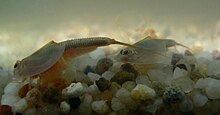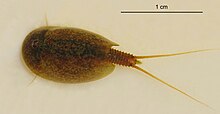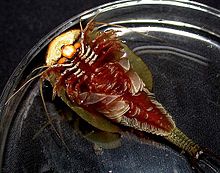Notostraca
| Notostraca Temporal range:
| |
|---|---|

| |
| Triops australiensis | |

| |
| Lepidurus apus | |
| Scientific classification | |
| Domain: | Eukaryota |
| Kingdom: | Animalia |
| Phylum: | Arthropoda |
| Class: | Branchiopoda |
| Superorder: | Calmanostraca |
| Order: | Notostraca G. O. Sars, 1867 |
| Genera | |
The order Notostraca, containing the single family Triopsidae, is a group of
Description
Notostracans are 2–5 centimetres (0.8–2.0 in) long, with a broad carapace at the front end, and a long, slender abdomen.[1] This gives them a similar overall shape to a tadpole, from which the common name tadpole shrimp derives.[1] The carapace is dorso-ventrally flattened, smooth, and bears no rostrum; it includes the head, and the two sessile compound eyes are located together on top of the head.[1] The two pairs of antennae are much reduced, with the second pair sometimes missing altogether.[2] The mouthparts comprise a pair of uniramous mandibles and no maxillipeds.[2]

The trunk consists of three regions; thorax I, thorax II and the abdomen. Thorax I is made up of 11 segments, each with a pair of well-developed limbs and the genital opening on the eleventh segment. In the female, it is modified to form a "brood pouch".[3] The first one or two pairs of legs differ from the remainder, and probably function as sensory organs.[3]
The somites on thorax II are fused into "rings", which varies in number between species and gender and appear to be body segments, but do not always reflect the underlying segmentation.[1] Each ring is made up of 2–6 complete or partial fused segments, and the number of legs on each body ring match its number of segments.[4][1] The legs become progressively smaller posteriorly,[3] with the last segments being legless.[1]
The limbless abdomen ends in a telson and a pair of long, thin, multi-articulate caudal rami.[5] The form of the telson varies between the two genera: in Lepidurus, a rounded projection extends between the caudal rami, while in Triops there is no such projection.[1]
Life cycle

Within the Notostraca, and even within species, there is variation in the mode of reproduction, with some populations
Ecology and distribution
Notostracans are
Evolution and fossil record
The
The "central autapomorphy" of the Notostraca is the abandonment of
Taxonomy
The extant members of order Notostraca composed a single family, Triopsidae, with only two genera, Triops and Lepidurus.[11] The problematic Middle Ordovician fossil Douglasocaris has been erected and placed in its own family Douglasocaridae by Caster & Brooks 1956, and may be ancestral to Notostraca.
The phenotypic plasticity shown by notostracan species make identification to the species level difficult.[11] Many putative species have been described based on morphological variation, such that by the 1950s, as many as 70 species were recognised.[11] Two important revisions – those of Linder in 1952[14] and Longhurst in 1955[15] – synonymised many taxa, and resulted in the recognition of only 11 species in the two genera. This taxonomy was accepted for decades,[11] "even attaining the status of dogma".[16] More recent studies, especially those employing molecular phylogenetics, have shown that the eleven currently recognised species conceal a greater number of reproductively isolated populations.[11]
Genera list
- Strudops Strud locality, Belgium, late Devonian (Fammenian)
- Chenops Yixian Formation, China, Early Cretaceous (Aptian)
- Jeholops Yixian Formation, China, Early Cretaceous (Aptian)
- Weichangiops Dabeigou Formation, China, Early Cretaceous
- Brachygastriops Dabeigou Formation, China, Early Cretaceous
- Lynceites Germany, Canada, Carboniferous
- Xinjiangiops Kelamayi Formation, China, Middle Triassic
Incertae sedis species
- "Notostraca" minor (often referred to as Triops cancriformis minor, or "Triops" minor in historic literature) Hassberge Formation, Germany, Late Triassic (Carnian)[17]
- "Notostraca" oleseni Yixian Formation, China, Early Cretaceous (Aptian)[18]
- "Calmanostraca" hassbergella Hassberge Formation, Germany, Late Triassic (Carnian)[18]
See also
References
- ^ ISBN 978-0-520-23939-5.
- ^ a b c d e J. K. Lowry (October 2, 1999). "Notostraca (Branchiopoda)". Crustacea, the Higher Taxa: Description, Identification, and Information Retrieval. Archived from the original on July 23, 2011. Retrieved February 7, 2011.
- ^ ISBN 978-0-471-35837-4.
- ^ Evolution and Phylogeny of Pancrustacea: A Story of Scientific Method - 44. Notostraca and Allies (Calmanostraca)
- ^ "Subclass 1. Branchiopoda". The Invertebrata (4th ed.). Cambridge University Press. 1961. pp. 368–375.
- ^ Self-Fertilization and the Role of Males in Populations of Tadpole Shrimp (Branchiopoda: Notostraca: Triops)
- ^ ISBN 978-3-540-67406-1.
- ISBN 978-0-88864-234-9.
- ISBN 978-1-4020-0658-6.
- S2CID 129231634.
- ^ )
- ^ Liu, Hongfu (1996). "New materials of Late Triassic Kazacharthra from Xinjaing". Acta Palaeontologica Sinica. 4 (35): 490–494. Archived from the original on 2013-04-14.
- ISBN 978-0-306-47366-1.
- .
- .
- S2CID 6767325.
- S2CID 90922613.
- ^ PMID 31245037.
External links
- Triops cancriformis media from ARKive
- L. D. Godfrey & L. A. Espino (February 2009). "Tadpole shrimp. Scientific name: Triops longicaudatus". UC Pest Management Guidelines. University of California, Davis.

